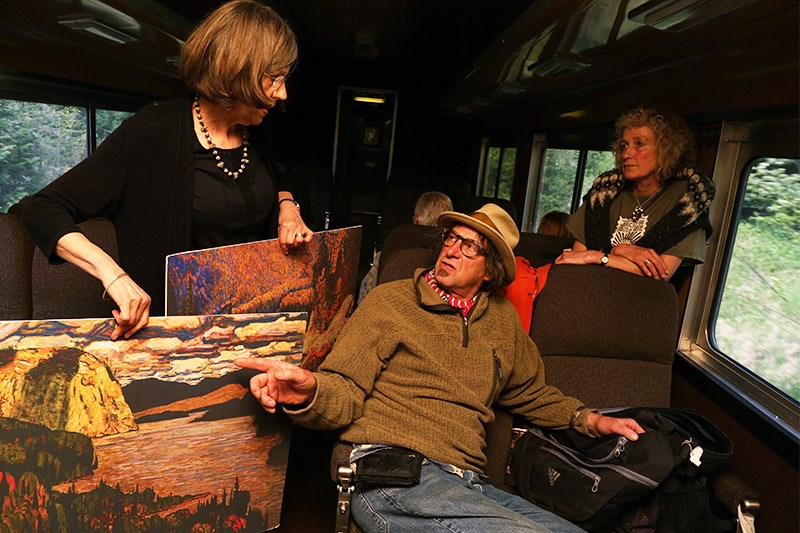A proposed plan seeking the resurrection of the Algoma Central Railway passenger service between Sault Ste. Marie and Hearst could include using a ‘high-rail’ bus converted for use on train tracks on weekends.
Branded as Mask-Wa Oo-Ta-Ban, or Bear Train, the group which hopes to operate the passenger service posted a 12-page report today by email.
The report recounts a round-table focus group held in May regarding the future of the passenger service, and includes proposed operating schedules and a new fee structure.
The proposed summer schedule could include using a ‘high-rail’ bus with a 40-passenger capacity to operate from Sault Ste. Marie and Hawk Junction on weekends.
Linda Savory-Gordon, who was involved in the round-table discussion and is a member of the Coalition for Algoma Passenger Trains, said the bus — which would be modified to run along the railway tracks — is an ideal solution for weekend campers who may not need to carry a lot of supplies.
People who want to carry more, said Savory-Gordon, would take the actual train, which is proposed to operate on some weekdays.
The high-rail bus could possibly be expanded for other uses, said Savory-Gordon.
“It would be fabulous to use for going to Searchmont, for example the North Pole Express, concerts and dinner theatre or just as a ski bus,” she said.
Each Monday and Friday during the proposed summer schedule, two trains would operate — one headed south in the morning from Hearst and another departing north from Sault Ste. Marie.
Each train would stop at Hawk Junction before returning to the community it left from earlier that day, said Savory-Gordon.
Passengers looking to continue down the line would need to transfer to the other train.Additionally, said Savory-Gordon, having each train leave from and return to the same community would mean the operators return home each night, cutting down on accommodation costs.
The proposed schedule would also ensure no conflicts between the passenger service and the Agawa Canyon Tour Train, which is still in regular operation.
Savory-Gordon said she would like to see the renewed passenger service operating as a sustainable operation.
“It’s going to start out in a more limited way, and then as we build toward more events and tourism destinations along the line, it is quite conceivable there will be more options as far as scheduling,” said Savory-Gordon.
The high-rail bus will not operate during the proposed winter schedule. Instead, the trains will depart Sundays and Fridays on a more limited schedule.
Attendees of the roundtable discussion represented various properties and communities between the Sault and Hearst.
Mask-Wa Oo-Ta-Ban is an effort led by Jason Gauthier, chief of the Missanabie Cree First Nation.
A work plan is still in progress said a statement emailed to SooToday from the office of Carolyn Bennett, the minister of Indigenous and Northern Affairs Canada (INAC).
Successful meetings were held in May with officials from Mask-Wa Oo-Ta-Ban and INAC, said the statement, and various funding approaches for the proposed renewal of passenger service were discussed.
“Transport Canada, INAC, MP (Terry) Sheehan and the minister’s office are in regular contact with the chief,” said the statement.
Requests by SooToday for comment from Gauthier and Mask-Wa Oo-Ta-Ban made over the last two weeks were not granted.
Carol Hughes, MP for Algoma—Manitoulin—Kapuskasing, said today that INAC has been fairly helpful, but that the Ministry of Transportation is the biggest hold up on getting the passenger service back up and running.
Hughes has tabled a number of petitions to the House of Commons urging the Liberal government to fund the operation of the passenger service, which was discontinued in July of 2015.
In early 2014, the Conservative-led government announced Transport Canada would cease a $2.2-million remote rail subsidy because some of the area it services is accessible by road.
Then-Liberal candidate Terry Sheehan said the service had ceased as a result of the Conservative MP of the day’s inability to communicate the importance of the passenger service to Transport Canada.
Transport Canada once again came to the same conclusion after the Liberals were voted to power in 2015, and the file was passed to INAC by Transport Minister Marc Garneau.
Hughes credits Gauthier’s lobbying for keeping pressure on the Liberal government to return the service to operation.
“If the First Nation wasn’t there, I don’t know that they would be that far along. At the same time, the fact that (the passenger train) is not running yet — the economic impact on communities and businesses is huge. You can’t turn a blind eye to that,” said Hughes.
